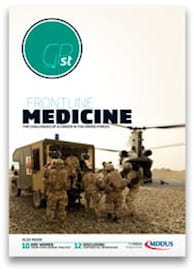DAY ONE
A 45-year-old father of two - Mr G - attends an out-of-hours GP unit complaining of severe headaches over the preceding week. He is examined by Dr A who records: “right-sided frontal headache over the past week with associated nausea but no vomiting. No reported visual upset or peripheral neurological symptoms. No recent injury. Fully orientated on examination; apyrexial; no meningism and no abnormality of discs.” Dr A prescribes the analgesic cocodamol and sends the patient home.
DAY THREE
Mr G’s wife phones her local general practice just after opening time requesting a house call due to her husband’s severe persisting headache. Dr B attends the patient later that morning. He makes handwritten notes of the visit recording again a “frontal/crown headache” over the previous week with nausea and some vomiting. The patient’s wife reports that the prescribed analgesics have had no effect. Dr B records no visual disturbance/recent URTI, photophobia or neck stiffness. He examines the patient and notes: “Full range of movement of neck.” Dr B makes a diagnosis of migraine and administers an injection of Cyclimorph – a combination drug of morphine and an anti-emetic. He instructs the patient to contact the practice again if the symptoms worsen or do not settle. He records this advice.
DAY SIX
Mr G is brought into the GP surgery by his wife. He is seen as an emergency patient by Dr C whose handwritten notes state “thumping pain towards back of the neck keeping the patient awake at night”. No visual upset is noted but nausea is still present. Otherwise all other findings are normal. The GP also notes “No neck stiffness, no rash. Kernig’s sign negative.” He prescribes co-codamol again.
DAY 15
Mr G develops a severe frontal headache and collapses. An ambulance is called and he is admitted to the Accident and Emergency Department and is found to be comatose. A CT scan reveals an extensive subarachnoid haemorrhage (SAH) with an intracerebral blood clot. Mr G is transferred to the ICU but remains unresponsive and is pronounced dead. A subsequent neuropathological report reveals the presence of a burst aneurysm in an arterial vessel.
A FEW months later the practice receives notification of a claim of negligence being raised by Mrs G against all the GPs involved in her husband’s care. Her solicitors allege that had the doctors correctly interpreted the ongoing and unremitting severe headaches as a sign of “warning leaks” of an impending SAH, Mr G could have been referred for neurosurgical intervention to repair the intracranial aneurysm, preventing his death.
MDDUS, who represents both Dr B and Dr C, commissions expert reports from a primary care specialist and a neurosurgeon. The GP expert cites the relative rarity of SAH and thewelldocumented difficulty in distinguishing the signs of early ‘warning leaks’ from those of more common conditions such as migraine or tension headache. The long time frame – nine days from the first report of headaches – also supports a non-serious cause, as does the long gap in seeking medical advice before Mr G’s collapse. Both doctors undertook a full and appropriate history and examination noting the absence of photophobia and neck stiffness that might lead to a diagnosis of SA or meningitis. In the opinion of the GP expert, the clinical actions of both doctors were entirely appropriate and consistent with a reasonable standard of care.
Expert opinion from the neurosurgeon also highlights the difficulty of diagnosing a slow onset SAH but confirms that had Mr G been investigated in hospital in the weeks before his collapse the aneurysm could have been repaired.
Another expert opinion commissioned by the solicitors acting for Mrs G takes a different view on the case stating that the prudent course of action given the ongoing severe headache and nausea would have been an urgent referral. The GP expert also criticises the administration of Cyclimorph by Dr B which may have exacerbated the patient’s condition.
Considering the risks of defending the case in court with legal costs likely to be in excess of any potential damages awarded, MDDUS opts to settle out of court.
KEY POINTS
- Have a high index of suspicion in unremitting severe headaches with nausea and vomiting – although SAH rarely presents in general practice.
- Keep accurate notes of all clinical findings (positive and negative) and advice to patients in order to clearly justify clinical decision-making.
- Decisions to defend cases in court or pursue an economic settlement are often pragmatic based on risk.
This page was correct at the time of publication. Any guidance is intended as general guidance for members only. If you are a member and need specific advice relating to your own circumstances, please contact one of our advisers.
Read more from this issue of Insight Primary

Save this article
Save this article to a list of favourite articles which members can access in their account.
Save to library


